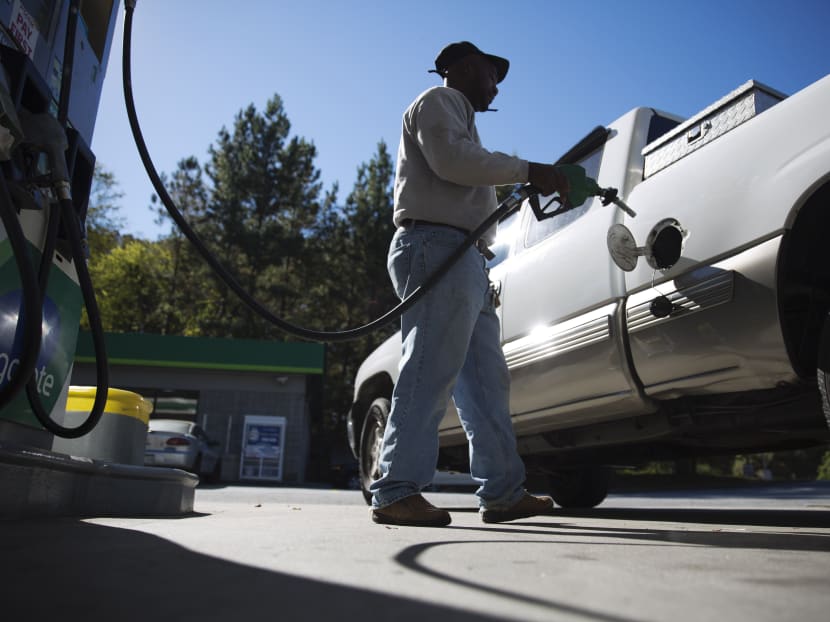Why oil is down by half, what it means for you
NEW YORK — The price of oil has fallen by nearly half in just six months, a surprising and steep plunge that has consumers cheering, producers howling and economists wringing their hands over whether this is a good or bad thing.

In this Oct 30, 2014 file photo, motorist Jerry Reed fills up his tank at a gas station in Atlanta. Photo: AP
NEW YORK — The price of oil has fallen by nearly half in just six months, a surprising and steep plunge that has consumers cheering, producers howling and economists wringing their hands over whether this is a good or bad thing.
The price of a barrel of oil is just under US$56 (S$73), down from a summer high of US$107, and lower than at any time since the United States was still in recession in the spring of 2009.
So what’s going on? A global imbalance of supply and demand that is rippling across the world economy, for better and worse.
SUPPLIES GO BOOM
Years of high oil prices, interrupted briefly by the recession, inspired drillers around the world to scour the earth’s crust for more oil.
They found it.
Since 2008 oil companies in the US, for example, have increased production by 70 per cent, or 3.5 million barrels of oil per day. To put that in perspective, that increase alone is more than the production of any OPEC member other than Saudi Arabia.
As US production was ramping up, turmoil in the Middle East and North Africa reduced supplies from Libya, Iran and elsewhere. A balance was struck: Increasing supplies from outside of OPEC and from Iraq’s recovering oil industry helped meet rising demand around the world as other OPEC supplies waivered.
But now those OPEC supplies look more certain despite continuing turmoil, and those non-OPEC supplies have swamped the market. OPEC estimated last week that the world would need 28.9 million barrels of its oil per day next year, the lowest in more than a decade. At the same time, OPEC countries plan to produce 30 million barrels of oil per day next year. That supply surplus is sending global prices lower.
DEMAND GOES BUST
Global demand is still expected to grow next year, but by far less than many thought earlier this year. The economies of China, Japan and Western Europe — the top oil consumers after the United States — all appear to be weakening. Oil demand falls when economic growth stalls.
The US is still the world’s largest consumer, but more fuel-efficient cars and changing demographics mean demand for oil and gasoline is not increasing. The Energy Department predicts a slight decrease in gasoline demand next year even though the price is expected to be sharply lower and the economy is expected to grow.
THE HAPPY CONSUMERS
For drivers, shippers, airlines and other consumers of fuel, there’s nothing not to like about the drop in oil prices.
The national average gasoline price has fallen for 81 straight days to US$2.55 a gallon, its lowest level since October of 2009, according to AAA. It’s US$1.15 a gallon cheaper than its high for the year, saving US households US$100 a month as they shop for holiday presents. “Any time gas prices go down that is a good thing,” said Mr Randy Daniels, 30, who was shopping recently at the Lenox Square Mall in Atlanta. “An extra 20 or 30 bucks in my pocket goes far.”
Diesel and jet fuel prices have also plunged, helping boost the profits and share prices of airlines and shippers. Heating oil is the cheapest it has been in four years, reducing home heating prices just in time for winter for many in the chilly Northeast.
THE WORRIED ECONOMISTS
Falling fuel prices act like a tax cut and help boost consumer spending, which in turn accounts for 70 per cent of the US economy. But economists are growing concerned that there are other, more troublesome forces at play.
The depth of oil’s plunge could be a signal that the global economy is struggling even more than economists think. A weak global economy could hurt the US economy by reducing exports, employment and spending, which together could outweigh the economic benefits of cheaper fuel.
THE PRODUCERS’ PAIN
For oil companies, oil-producing states, and oil-exporting countries, the oil price collapse is painful.
Oil companies generally keep producing oil from wells they’ve already drilled, but lower prices sharply reduce revenue and force them to cut back spending on new exploration projects. BP announced last week it would try to trim US$1 billion in spending next year in a move that analysts say could result in thousands of job cuts.
States that rely on taxes from energy production such as Alaska, North Dakota, Oklahoma and Texas will see lower revenues and some have already had to trim budgets.
Major oil exporters such as Iran, Iraq, Russia and Venezuela rely heavily on revenues from state-owned oil companies to run their governments and are struggling under major budget shortfalls. For example, Bank of America estimates that every US$1 drop in the global price of oil costs Venezuela US$770 million in annual revenue. Current prices are now US$47 below last year’s average, putting the country on pace for a US$36 billion reduction in revenue. AP





